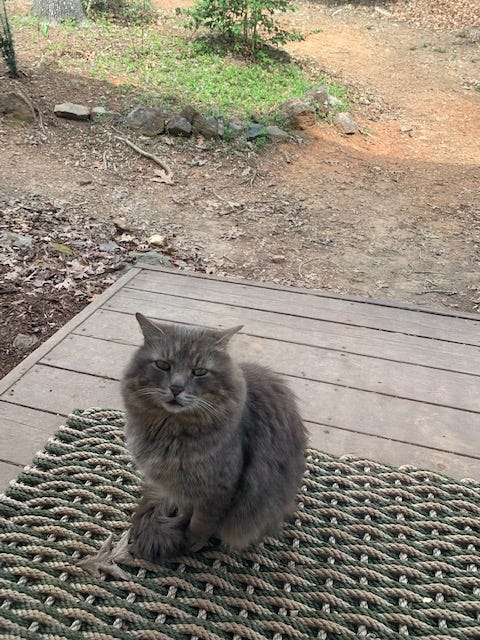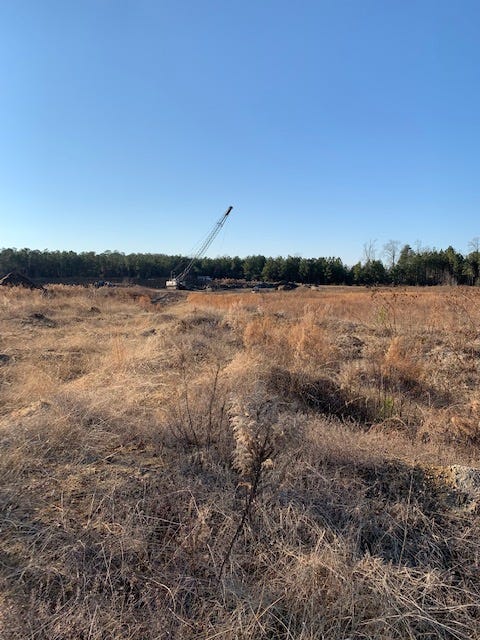It’s still cat month, and we’ve come to the trickiest, most destructive of the cat species: the common (roaming) domestic cat. And we’re going to be totally upfront with you: we have two-point-five indoor-outdoor cats.
Two of them, Julius and Coco, use a cat door to go in and out, and we’ve never tried to put a leash on either one of them. The point-five cat, Randy (pictured above), is not technically ours and never comes inside, but has been hanging around our house a couple of days a week for almost five years (we think he makes a circuit in the neighborhood). They all eat dry cat food, and Randy eats dry cat food and sometimes a cooked giblet from one our weekend chickens. We’ve tried to trap him to take him to the vet, but he’s too smart for that. We wound up catching a possum instead. All three are smart, healthy, sweet, lovable, and attractive.
So why are we “admitting” this, instead of proudly proclaiming our care of these fine felines? Well, domestic cats that go outside are bad for the ecosystem. They decimate populations of birds, and negatively impact populations of small mammals and reptiles too. Outdoor cats like ours have contributed to the extinction of 63 species of birds—and free-roaming cats are the second biggest contribution to the immense overall decline of bird populations in the U.S. and Canada. (The greatest threat is habitat loss.)
Julius and Coco are not really bird hunters—where we live, it’s much easier for them to catch voles and mice, plus the occasional squirrel for Julius. Coco doesn’t even kill that many mice (she doesn’t like the way they taste, Bea says). But it’s also true that we don’t watch them all the time—we can’t, since we let them roam freely.
At the North Carolina Museum of Natural Sciences, we learned about a cool opportunity to participate in citizen science. It’s called Cat Tracker 2.0. This study—you can sign up here—uses a small tracking device to follow healthy free-roaming indoor-outdoor cats to find out where they go, what they do, and how much damage they’re doing.
You can also watch this video that summarizes the first round of research from Cat Tracker, which followed more than 900 cats from all across the world:
Cats (and dogs) also eat a meat-centered diet, which as we know is also damaging to the ecosystem—but we can. As Ceri Perkins writes for TED.com:
In fact, while cats are considered “obligate carnivores” — meaning that their diet requires nutrients found only in animal flesh — modern dogs are such omnivores that plant-based foods, including non-meat protein sources such as yeast, insects and (soon!) lab-grown protein, are realistic and healthy alternatives. (In fact, major pet food companies are already developing insect-based dog and cat foods.) Talk to your vet about how much protein your particular dog needs and go from there.
At the very minimum, says Okin, leave the human-grade cuts for humans. Advertisers have persuaded us to be leery of budget brands made of “meat by-products,” suggesting these are poor-quality fillers that humans wouldn’t eat, so why give them to our dogs? “Most of the time, they’re confusing ‘wouldn’t’ with ‘couldn’t’,” Okin explains. A by-product is, after all, a culturally-defined concept — something that doesn’t make it to supermarket shelves. But meat by-products’ nutritional value remains high, and your dog will not know the difference.
Indoor-only cats produce another big problem, which is their waste. According to Perkins, American cat and dog poop fills as much landfill space as the total trash produced by the state of Massachusetts!
So what are some things you can do to reduce the environmental impact of your cats?
1. Adopt your cat from an animal shelter!
2. Spay or neuter your cat! This is really the best thing you can do to help your cat live a long, healthy life—and to help the birds and other critters too.
3. Feed your cat cheap cat food—for real! Even though cats have to eat meat (they are “obligated” to be carnivores, remember), cheaper, dry cat food has less meat in it, so it’s not as hard on the planet, and many vets say it’s better for their teeth. Though it’s no longer available, Mamie’s cats Mischief and Cassie both ate the cheap brand Deli Cat their whole lives—and they both lived into their twenties!
4. If you can, keep your cat indoors or monitor them closely (on a leash or like our very protective neighbor David does, by sitting outside with them when they are outdoors). You can also keep your cats indoors at dawn and dusk, when their prey is most active and vulnerable. This Jackson Galaxy video (from the fun reality show My Cat from Hell) has some great tips on keeping indoor cats happy:
5. Don’t buy regular cat litter! Both clumping litter and absorbent litter are produced by climate-harmful mines, which involves clearcutting the land and strip mining the earth. Mamie and Grampa actually live near a kitty litter mine in Walkerton, and Bea and I rode our bikes to see it in December. Let’s just say a kitty litter mine looks just about as nice as it sounds. Plus, people like Mamie and Grampa have to say “go past the kitty litter mine” when they give directions in their town! Which is generally depressing (as a landmark) and completely unnecessary.
Here is the Walkerton kitty litter mine, by the way:
If you don’t want to see forests turned into strip mines, you can use newspaper- or pine-needle based litter, like Feline Pine or Yesterday’s News. (Or make your own kitty litter!) Here’s a roundup of the best eco-friendly cat litter brands out there.
6. Make your cat toys out of stuff you already have, and generally be mindful of the ways you can reduce the things you buy just because you own a cat. For example, cat beds? As useless as strip-mined cat litter! Cats sleep just about anywhere, which is just one of the many awesome things about them.
We’ll be back Friday with a post from Bea about homemade cat toys, and her tips on how to bond with a newly-adopted cat.
What do you do to keep your cats—and the animals that share your ecosystem—safe? How do you keep indoor cats happy and exercised? Any luck with bells and other wildlife-warning-system collars?







